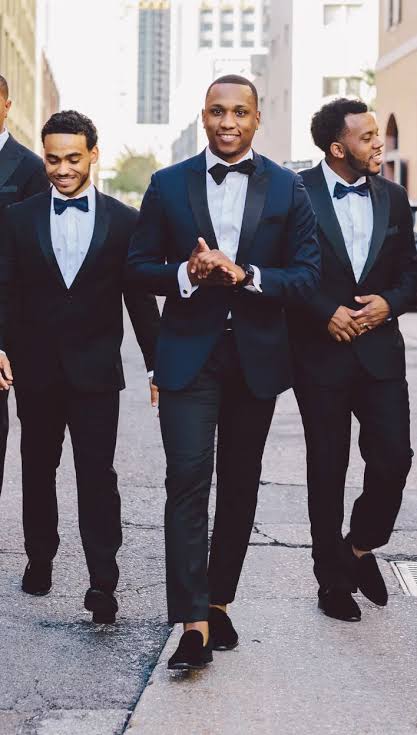A blue tuxedo’s a statement piece that encapsulates both mystery and sophistication, much like an Oscar Wilde quip that lingers in the air long after the words have been spoken. Opting for a blue tux instead of the usual black—it’s a nod to daring elegance, both classic and modern. It’s like choosing to stand out in a world of penguin suits, saying, “I’m here, and I’m bringing my own flair.”
The history of the blue tuxedo is as intriguing as the color itself. The blue dinner jacket rose in popularity as an alternative to the traditional black as fashion calendars turned. Back in the day, legends like Duke Ellington and Frank Sinatra embraced blue with gusto, adding an unexpected twist to evening wear. It’s not just about looking good; it’s about conveying a sense of individuality and confidence.
Imagine stepping into your blue tuxedo, each thread woven not just with fabric but with possibilities. You’re striding into the world with purpose, knowing that setbacks are just threads in the larger tapestry of your life.
Blue Tuxedo Origins
The sartorial elegance of the blue tuxedos—what a delightful tale woven through the fabric of fashion history! Let’s dive into the origins and evolutions of this dapper choice.
The tuxedo itself was born from the traditional dinner jacket in the late 19th century. While classic black has often ruled the eveningwear roost, the blue tux started its rise in the early to mid-20th century. Icons like the debonair Duke of Windsor were champions of this chic alternative, donning it at exclusive soirées and making it a fashionable choice for the discerning gentleman.
Why blue? Besides the undeniable charm of the color, blue hues often offer a softer, more approachable look under artificial lighting than stark black, making it a favorite for evening events. The dark hues like midnight blue mimic the charm of deep evening skies—mysterious, profound, and ever so slightly rebellious.
The Origin and Role of Lapels
Initially, tuxedo lapels borrowed from Victorian dinner jackets, which were adaptations of tailcoats. Lapels developed primarily from military dress uniforms, evolving into the shawl and peak styles we recognize today. Shawl lapels offer a smooth, continuous curve, originally designed for smoking jackets—symbols of leisure and style. Meanwhile, the peak lapels are all about making a statement, with their assertive edges and sharp angles exuding confidence and distinction.
While tuxedos traditionally feature lapels matching the jacket’s fabric, contrasting lapels have carved out a niche, adding visual intrigue. A darker or differently textured lapel against a blue tuxedo offers a subtle yet striking contrast, reflecting personal flair.
When the hues of a tuxedo and its lapels are close yet distinct, it creates an effect that whispers luxury and deliberate style—appealing to those who appreciate nuance over bold statements.
Hues Variety for a Blue Tuxedo
Now, when it comes to the spectrum of blue available today, it spans quite the range. Let’s unravel some of the popular hues you’ll find gracing closets and boutiques:
- Midnight Blue Star: The close companion of black, it’s often preferred for formal evening functions. The subtlety of its sheen in the right light makes it a top choice for those who want classic with a twist.
- Navy Blue: Navy evokes notions of the sea, strength, and tradition. A navy tux is versatile, effortlessly oscillating between formal and semi-formal occasions.
- Royal Blue: Ah, the hue of regality! It commands attention and exudes confidence. This shade is bold without being ostentatious.
- Cobalt Blue: Vibrant and eye-catching, cobalt is for the avant-garde who appreciate making a statement.
- Powder Blue: More relaxed and playful, it’s perfect for daytime events or less formal gatherings. It speaks to those with a flair for the whimsical.
- Sapphire Blue: Rich and luxurious, much like the gemstone, this hue is often associated with elegance and allure.
- Turquoise Tinge: A bit on the lighter spectrum, the whispers of green in this tux can make it refreshingly unique.
The market is a dynamic tapestry with these celestial shades shaped by trends, fabric innovations, and the tastes of the sartorially daring. Midnight and navy blues often top the popularity charts due to their versatility and classic appeal, while royal and cobalt cater to more trend-forward shoppers.
The blue tux offers a palette as broad as the wearer’s imagination, each shade a brushstroke on the canvas of personal style. Whether it’s the understated sophistication of midnight or the playful charisma of cobalt, there’s a blue tux ready to match every mood and occasion.
The Evolution of the Blue Tuxedo Cut
The Classic Cut
Initially, the blue tuxedo mirrored the traditional black tux, characterized by a single-button closure, broad peak lapels, and a smooth satin finish. It was all about clean lines and tailoring that hugged the body just right.
The Double-Breasted Delight
The mid-20th century saw the rise of the double-breasted tux. Its overlapping fabric allowed for a more expressive cut, adding a layer of sophistication. In blue, it became a symbol of both renegade style and timeless elegance.
The Slim Fit Sensation
As trends leaned towards a more tailored look, the slim-fit tuxedo emerged. Nail-bitingly fashionable, this cut is all about sleek silhouettes and modern edges—an embodiment of contemporary style that doesn’t shy away from the spotlight.
The Shawl Lapel Look
Offering a softer, more rounded alternative to the sharp lines of the peak lapel, the shawl lapel is a nod to elegance and a favorite for evening events. In blue, it creates a delicate balance of classic and chic.
The Three-Piece Wonder
Sometimes, a waistcoat is all it takes to elevate a tuxedo from distinguished to dapper. The blue three-piece adds an extra layer of depth and texture, perfect for those looking to make a polished impression.
Icons of Style Who’ve Embraced the Blue Tuxedo
- Frank Sinatra—Known for his suave style, Sinatra often favored a classy blue tux for his performances, adding extra sheen to his legendary aura.
- Elvis Presley—The King of Rock ‘n Roll was known to occasionally step out in vibrant blue, challenging conventional fashion norms.
- George Clooney—This contemporary icon effortlessly blends classic charm with modern flair, frequently opting for suave shades of blue for red-carpet events.
- Ryan Gosling—Another modern-day style savant, Gosling wears blue like he was born to it, often choosing refined shades and modern cuts for a striking ensemble.
- David Beckham—The renowned style icon regularly partners his impeccable grooming with blue tuxedos, showcasing a knack for contemporary elegance.
The blue tuxedo is much like a beautifully tailored story—it evolves, adapts, and shines with the personality of the wearer. As we navigate this evolution, may your chosen cut and shade reflect your inimitable style and poise.
Prom Popularity and Fashion Aspirations
The rise of the blue tuxedo in prom culture can be attributed partly to the fashion influence of celebrity icons. Youngsters observe style stalwarts gracing red carpets in dazzling blue shades and aspire to emulate this debonair elegance at their own milestone events. It’s about capturing those fleeting moments where sophistication mingles with youthful optimism—a snapshot of coming-of-age with panache.
Moreover, proms are opportunities that invite a break from the mundane, and what better way to mark this transition than with the suave sophistication of a blue tux? Here, youth meet tradition, wrapping themselves in a garment with historical gravitas while making it their own through color and fit choices.
The blue tuxedo, with its evolving cuts, colors, and cultural significance, isn’t just a garment—it’s part of a picture that captures moments, memories, and the journey of fashion’s ever-shifting landscape.
So, pick the shade that sings to your soul. In a world of monochrome formality, your blue tux is a gentle rebellion, as fluid and vast as the ocean itself. Cheers to great fashion adventures!






